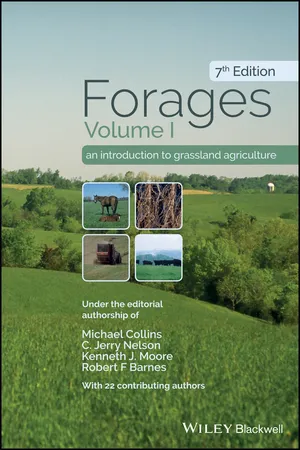
Forages, Volume 1
An Introduction to Grassland Agriculture
- English
- ePUB (mobile friendly)
- Available on iOS & Android
Forages, Volume 1
An Introduction to Grassland Agriculture
About this book
Forages, Volume I, Seventh Edition is themost comprehensive text available for teachers of undergraduate Forages courses. This edition will provide students with a good balance of scientific principles, to aid in integrating the concepts they learn, and practical information on forage identification, plant characteristics, management, and utilization that can be used by forage management practitioners. Grassland ecosystems are extremely complex, including the plant/animal interface as well as the soil/climate/forage interface and the text must support understanding and integration of all of these considerations. The coverage of the science behind the plant characteristics and responses make the book applicable in many parts of the world, while other region-specific management information relates mainly to North America. This edition has been updated to address emerging areas of study, including the use of forage plants as bioenergy crops. The editors also address the renewed national interest in environmental issues such as water quality, global climate change and eutrophication in the Gulf. This edition also addresses the role of forages for wildlife habitat and food sources, another area of increased interest in recent years. These revisions respond to the generational change taking place among forage scientists and teachers in recent years.
Frequently asked questions
- Essential is ideal for learners and professionals who enjoy exploring a wide range of subjects. Access the Essential Library with 800,000+ trusted titles and best-sellers across business, personal growth, and the humanities. Includes unlimited reading time and Standard Read Aloud voice.
- Complete: Perfect for advanced learners and researchers needing full, unrestricted access. Unlock 1.4M+ books across hundreds of subjects, including academic and specialized titles. The Complete Plan also includes advanced features like Premium Read Aloud and Research Assistant.
Please note we cannot support devices running on iOS 13 and Android 7 or earlier. Learn more about using the app.
Information
PART I
CHARACTERISTICS OF FORAGE SPECIES
Chapter 1
Forages and Grasslands in a Changing World
Grassland Terminology
Table of contents
- Cover
- Title Page
- Copyright
- Preface
- List of Contributors
- In Memoriam
- The Metric System
- The Last of the Virgin Sod
- Flesh is Grass
- PART I CHARACTERISTICS OF FORAGE SPECIES
- PART II FORAGE MANAGEMENT
- PART III FORAGE UTILIZATION
- Appendix: Common and Botanical Names of Forages
- Glossary
- Index
- EULA